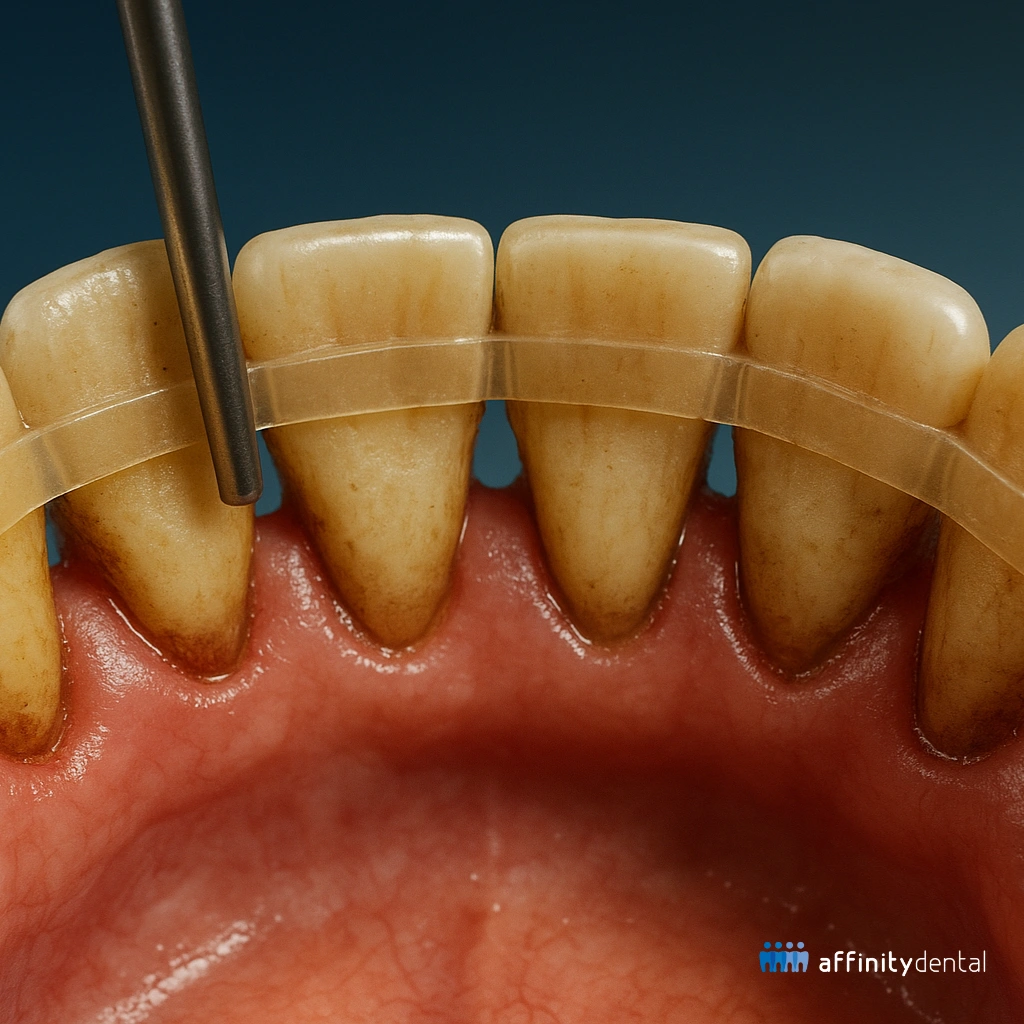
Periodontal Splinting
Saving Loose Teeth Together
When you think of dental care, most people focus on cavities or missing teeth—but sometimes, the challenge lies in teeth that are still present but have become loose. This mobility can make eating, speaking, and smiling uncomfortable or even distressing. If you’ve noticed your teeth shifting or becoming unstable, you’re not alone. It’s a common sign of periodontal disease—a serious gum infection that weakens the
structures supporting your teeth.
At Affinity Dental Clinics, we believe that preserving your natural teeth, whenever possible, is always worth the effort. That’s why we offer Periodontal Splinting in the Philippines, a minimally invasive and effective way to stabilize loose teeth and extend their lifespan. With our team of experienced dental professionals and advanced facilities across Makati, BGC, Alabang, Ortigas, Parañaque, and Cebu, we are here to help you regain confidence in your smile.
What Is Periodontal Splinting?
Periodontal Splinting is a technique used to stabilize mobile teeth by bonding them together, distributing biting forces more evenly, and relieving stress on the weakened supporting structures. It is most commonly used in patients suffering from advanced periodontal disease, where the bone and gums holding the teeth in place have deteriorated.
By linking the loose teeth to stronger neighboring teeth, a “splint” is formed—just like a cast would support a broken arm. The goal is to keep your teeth functional and in place while other periodontal treatments are performed to restore gum health.
Why Do Teeth Become Loose?
Loose teeth can happen for several reasons, but most often, it’s due to periodontal (gum) disease. Here’s why:
• Bone loss around the teeth roots occurs over time.
• Without adequate support, the teeth begin to shift or wobble.
• Daily functions like chewing or grinding add stress to these already weakened teeth.
Sometimes, trauma (like an injury or accident), bruxism (chronic grinding), or malocclusion (bad bite alignment) can also cause or worsen tooth mobility.
Who Can Benefit from Periodontal Splinting?
You may be a candidate for periodontal splinting if:
• Your teeth are not yet candidates for extraction and still have enough root support.
• You feel discomfort or instability when chewing or biting.
• You’re undergoing treatment for gum disease but want to preserve your natural teeth as long as possible.
At Affinity Dental Clinics, we take a conservative approach: we only recommend splinting if there’s a good chance of saving the teeth, and we always combine it with a comprehensive plan to improve your overall gum health.
Types of Periodontal Splints
There are different types of splints depending on the location of the loose teeth and the severity of their condition:
• Usually applied using composite resin and dental wire or fiber reinforcement.
• Ideal for short-term stabilization during active periodontal treatment.
• Can be done chairside in a single appointment.
• Involves creating a bridge-like structure that permanently joins several teeth.
• Often used for anterior teeth (front teeth) for better aesthetics and function.
• Fabricated in a dental laboratory for long-term use.
• Similar to retainers, used for nighttime wear or during healing phases.
• Less commonly used for periodontal splinting unless part of a larger treatment plan.
At Affinity Dental Clinics, we specialize in customizing the right type of splint for your condition—balancing stability, comfort, and aesthetics.
What to Expect During the Procedure
The process of periodontal splinting is usually quick and minimally invasive:
Your dentist will first assess your gums, teeth mobility, and supporting bone using clinical exams and digital X-rays. Cone Beam CT scans may be used in more complex cases to evaluate the jaw bone in 3D.
Before splinting, we ensure that the underlying gum infection is treated through scaling, root planing, or other periodontal therapies. Splinting without addressing the cause would only provide temporary relief.
The teeth are cleaned and prepared. A dental material (usually fiber-reinforced composite or bonding resin) is used to splint the teeth together. The procedure is typically painless and completed in one visit.
You’ll return for check-ups to monitor the healing of the gums and ensure the splint is functioning properly.
Advantages of Periodontal Splinting
✅
Preserves natural teeth
Helps delay or avoid extractions for teeth that still have viable support.
✅
Restores function
Makes it easier and more comfortable to eat and speak.
✅
Improves aesthetics
Prevents shifting or spacing between teeth, especially in the smile zone.
✅
Boosts confidence
Knowing your teeth are stable again can dramatically improve self-esteem.
✅
Supports long-term healing
Splinting stabilizes the teeth, which can help the gums and bone heal more effectively when combined with periodontal therapy.
When Is Tooth Extraction Better?
While we strive to save natural teeth whenever possible, there are cases where splinting isn’t the best option, such as:
• Advanced gum disease not responding to treatment
• Chronic infections that risk affecting surrounding teeth
In such cases, Affinity Dental Clinics offers alternatives such as dental implants, bridges, or partial dentures to restore your bite and smile. We’ll always be honest with you about your options and help you make an informed decision.
Our Approach at Affinity Dental Clinics
At Affinity, saving smiles is at the heart of what we do. Whether you come in with early gum disease or loose teeth needing splinting, we treat each case with the same level of care and clinical excellence.
Why patients trust us:
Caring for Your Splinted Teeth
Once you’ve had your teeth splinted, proper oral hygiene is crucial to prevent further damage or recurrence of gum disease.
• Use interdental brushes or floss threaders to clean around the splint.
• Avoid biting hard foods (like ice or nuts) that could stress the splint.
• Maintain regular checkups every 3–6 months.
Our dentists will give you specific instructions tailored to your case and guide you every step of the way.
Reclaim Your Smile—One Tooth at a Time
Having loose teeth doesn’t have to mean losing them. With timely and skilled treatment like Periodontal Splinting, many teeth can be saved and stabilized for years. At Affinity Dental Clinics, we combine science and compassion to help you keep your natural smile longer—safely and confidently.
Book your consultation today and ask us about Periodontal Splinting in the Philippines—because every tooth is worth saving.
Book an Appointment
One moment, your message is being sent...
Please wait for the confirmation message before going back or closing your browser.
Sub heading
Content Place Here without Image

Content Continuation
Sub heading

Content Place Here without Image
Content Continuation
Sub heading

Content Description
Sub heading

Content Description Numbered
Intro Paragraph
Additional (Optional)
- Items
- Items
- Items
- Items
Component for Direct Content without image
Intro Paragraph
2nd Pragraph Optional
Closing paragraph
Component for Steps Content without image
Intro Paragraph
Text Description
- This list is optional, if the content does not have bulleted items remove the "ul and /ul"
- Items
- Items
Outro Paragraph (Optional)
Component for Steps Content with image

Intro Paragraph
Text Description
- This list is optional, if the content does not have bulleted items remove the "ul and /ul"
- Items
- Items
Outro Paragraph (Optional)
Other design for itemized content
Intro (copy this if there are more paragraphs)
Text Description
Table Title No Image
| Column Heading | Column Heading | Column Heading | Column Heading | Column Heading |
|---|---|---|---|---|
| Row Data | Row Data | Row Data | Row Data | Row Data |
Table Title with Image

| Column Heading | Column Heading | Column Heading | Column Heading | Column Heading |
|---|---|---|---|---|
| Row Data | Row Data | Row Data | Row Data | Row Data |
Frequently Asked Questions
Answer
Answer
Answer






